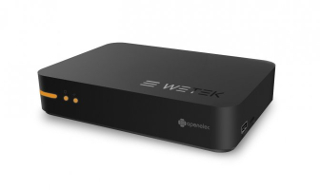
Review - Part 1
I got my WeTek OpenELEC box a few days ago but haven't had a lot of time to test it out.
When you plug it in for the first time a wizard starts and asks a few questions to configure the device.
The first issue that got me is it looks for your network. I knew it had wireless, but none of my access points were showing up. Turns out 'wireless' is disabled from factory. A quick check box fixes it, but you shouldn't have know how to do that outside the wizard.
Once up and running I was very impressed at the interface speed. Keep in mind my previous Kodi hardware was a hacked Apple TV 2 and a 2010 Mac Mini. I am still running the default skin but plan to test some of the more robust options.
What I liked even more is the remote. It is a custom version for OpenELEC and wow is it nice to have dedicated buttons for things like right click menus or even a 'home' button.
The second thing that caused some grief was mapping to my QNAP NAS shares. I don't know a lot about Windows other than it is a necessary evil for me to play games.
My local workgroup name has been TARDIS for years, and all my device names are somehow Dr Who related (actors, companions, etc). For whatever reason, the WeTek would not see this workgroup name.
After various attempts at different configurations I ended up having to set my NAS to 'WORKGROUP' and then all my shares were available. This is something I will revisit.
I let it pull all the meta data for my Movie library. This went MUCH faster then the ATV2, but not quite as fast as the Mac Mini.
I played a few AVI, MP4, and MKV files with no issues. Because the ATV2 is limited to 720p I don't have much content at higher resolutions. I plan to download Big Buck Bunny to test with for my follow-up review.
I like you can turn the device on/off via remote.
My WeTek shipped with OpenELEC 5.1.0 which I can not verify as an official version anywhere. Most forum posts said they were on 5.0.8, so maybe things are being tweaked as product is sent out. I was prompted to upgrade to the latest beta but am going to hold off until final release.
I did not have time to test the tuner, which was my main reason to purchase this device. Live TV and DVR functionality will be the focus of my next post.